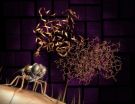(Press-News.org) COLUMBIA, Mo. – Media articles and nutritionists alike have perpetuated the idea that for healthy metabolisms individuals should consume small meals multiple times a day. However, new research conducted at the University of Missouri suggests all-day snacking might not be as beneficial as previously thought, especially for obese women.
"Our data suggests that, for obese women, eating fewer, bigger meals may be more advantageous metabolically compared to eating smaller, more frequent meals throughout the day," said the study's lead author, Tim Heden, a doctoral student in MU's Department of Nutrition and Exercise Physiology. "Eating larger meals less often lowered blood-fat levels. Over time, consistently eating fewer, larger meals each day could lower the women's blood-fat levels and thereby lower their risk of developing heart disease."
Heden and other MU researchers studied how meal frequency affected blood-sugar and blood-fat levels in eight obese women throughout two 12-hour periods on two separate days. All of the women consumed 1,500 calories. During the two different testing days, the participants consumed three 500-calorie liquid meals or six 250-calorie liquid meals. Throughout the 12-hour time frames, researchers tested sugar and fat levels in the women's blood every 30 minutes. Women who consumed three meals had significantly lower fat in their blood.
"The mass media and many health care practitioners often advocate eating several small meals throughout the day," Heden said. "However, when we examined the literature, we didn't find many studies examining or supporting this popular claim. This lack of research led to our study, which is one of the first to examine how meal frequency affects insulin and blood-fat levels in obese women during an entire day of eating."
More than one-third of Americans are obese, and these individuals are especially at risk for heart disease, the leading cause of death in the country, according to the Centers for Disease Control and Prevention. Heden says the research could help nutritionists and medical professionals develop strategies to improve the health of obese women.
"With multiple meals throughout the day, you have to be careful. If you start consuming several meals, there's more potential to overeat or to make unhealthy snack choices with easily accessible junk food," said Jill Kanaley, professor in the Department of Nutrition and Exercise Physiology and study co-author. "Some people are good at making efforts to eat healthy snacks; however, most people aren't, and they end up taking in too many calories. The more times you sit down to eat, the more calories you're probably going to take in."
Obese women would benefit from consuming three balanced meals a day, Heden and Kanaley agree.
INFORMATION:
The study, "Meal Frequency Differentially Alters postprandial Triacylglycerol and Insulin Concentrations in Obese Women," will be published in the journal Obesity.
The Department of Nutrition and Exercise Physiology is jointly administered by MU's College of Agriculture, Food and Natural Resources, College of Human Environmental Sciences and School of Medicine.
Eating fewer, larger meals may prove healthier for obese women
Consuming 3 substantial meals instead of 6 small meals lowered amount of fat in women's blood; Over time, could decrease women's risk of developing heart disease
2012-12-06
ELSE PRESS RELEASES FROM THIS DATE:
Fire and ice: Wildfires darkening Greenland snowpack, increasing melting
2012-12-06
SAN FRANCISCO—Satellite observations have revealed the first direct evidence of smoke from Arctic wildfires drifting over the Greenland ice sheet, tarnishing the ice with soot and making it more likely to melt under the sun.
At the American Geophysical Union meeting this week, an Ohio State University researcher presented images from NASA's Cloud-Aerosol Lidar and Infrared Pathfinder Satellite Observation (CALIPSO) satellite, which captured smoke from Arctic fires billowing out over Greenland during the summer of 2012.
Jason Box, associate professor of geography at ...
Georgia State physicist, international researchers discover fastest light-driven process
2012-12-06
A discovery that promises transistors – the fundamental part of all modern electronics – controlled by laser pulses that will be 10,000 faster than today's fastest transistors has been made by a Georgia State University professor and international researchers.
Professor of Physics Mark Stockman worked with Professor Vadym Apalkov of Georgia State and a group led by Ferenc Krausz at the prestigious Max Planck Institute for Quantum Optics and other well-known German institutions.
There are three basic types of solids: metals, semiconductors, used in today's transistors, ...
X-ray laser helps slay parasite that causes sleeping sickness
2012-12-06
An international team of scientists, using the world's most powerful X-ray laser, has revealed the three dimensional structure of a key enzyme that enables the single-celled parasite that causes African trypanosomiasis (or sleeping sickness) in humans.
With the elucidation of the 3D structure of the cathepsin B enzyme, it will be possible to design new drugs to inhibit the parasite (Trypanosoma brucei) that causes sleeping sickness, leaving the infected human unharmed.
The research team, including several ASU scientists, is led by the German Electron Synchrotron (DESY) ...
Researchers identify proteins that indicate which kidney tumors are most likely to spread
2012-12-06
TORONTO, Dec. 5, 2012—Researchers at St. Michael's hospital have identified 29 proteins that are likely to be involved in the spread of kidney cancer. The discovery will help physicians recognize which tumours are going to behave more aggressively and provide those patients with more intensive treatment and closer followup.
"Metastatic renal cell carcinoma is one of the most treatment-resistant malignancies and patients have dismal prognosis," said Dr. George M Yousef, a laboratory pathologist. "Identification of markers that can predict the potential of metastases will ...
Clinical trial tests rice bran to prevent cancer
2012-12-06
A recent University of Colorado Cancer Center review in the journal Advances in Nutrition shows that rice bran offers promising cancer prevention properties. Meanwhile, an ongoing clinical trial is testing the effectiveness of rice bran in preventing the recurrence of colon cancer.
"While I have been trained as a molecular toxicologist, I am excited about the opportunities to deliver bioactive, cancer fighting compounds with food, and this has led to my focus now primarily on the multiple drug-like characteristics of rice bran," says Elizabeth P. Ryan, PhD, CU Cancer ...
Adolescents under pressure to speak 'properly'
2012-12-06
EAST LANSING, Mich. — As adolescents transition to adulthood, the pressure to meet adult expectations – such as speaking properly – may be greater than expected, according to a new study by a Michigan State University researcher.
Suzanne Evans Wagner, assistant professor of linguistics, has proven for the first time that language changes with age in addition to community pressures. And, surprisingly, college and post-high school ambitions play a huge role.
"It seems as if in high school, students who want to go to a good college are the ones who early on begin to dial ...
Exercise affects reproductive ability in horses
2012-12-06
In the latest issue of the Journal of Animal Science, researchers at Clemson University and the University of Florida examine the impact of exercise on mare reproductive health and embryo transfer.
In the study, researchers divided light-horse mares into three research groups: no exercise (control), partial-exercise and full-exercise. Their goal was to measure reproductive blood flow and embryo number and quality. Partial-exercise mares were moderately exercised for 30 minutes daily during the periovulatory period and rested after ovulation for seven days. Full-exercise ...
NASA-NOAA satellite reveals new views of earth at night
2012-12-06
VIDEO:
This new global view and animation of Earth’s city lights is a composite assembled from data acquired by the Suomi NPP satellite. The data was acquired over nine days in...
Click here for more information.
Scientists unveiled today an unprecedented new look at
our planet at night. A global composite image, constructed using
cloud-free night images from a new NASA and National Oceanic and
Atmospheric Administration (NOAA) satellite, shows the glow of
natural and ...
New report finds increase in media coverage of synthetic biology
2012-12-06
WASHINGTON – Press coverage of synthetic biology in the United States and Europe increased significantly between 2008 and 2011, according to a report released today by the Synthetic Biology Project at the Woodrow Wilson International Center for Scholars.
The report, Trends in American and European Press Coverage of Synthetic Biology: 2008 – 2011, builds on the project's earlier study of US-EU press coverage between 2003 and 2008. Synthetic biology, an area of research focused on the design and construction of new biological parts and devices, or re-design of existing ...
Synthetic fuel could eliminate US need for crude oil
2012-12-06
The United States could eliminate the need for crude oil by using a combination of coal, natural gas and non-food crops to make synthetic fuel, a team of Princeton researchers has found.
Besides economic and national security benefits, the plan has potential environmental advantages. Because plants absorb carbon dioxide to grow, the United States could cut vehicle greenhouse emissions by as much as 50 percent in the next several decades using non-food crops to create liquid fuels, the researchers said.
Synthetic fuels would be an easy fit for the transportation system ...
LAST 30 PRESS RELEASES:
How talking slows eye movements behind the wheel
The Ceramic Society of Japan’s Oxoate Ceramics Research Association launches new international book project
Heart-brain connection: international study reveals the role of the vagus nerve in keeping the heart young
Researchers identify Rb1 as a predictive biomarker for a new therapeutic strategy in some breast cancers
Survey reveals ethical gaps slowing AI adoption in pediatric surgery
Stimulant ADHD medications work differently than thought
AI overestimates how smart people are, according to HSE economists
HSE researchers create genome-wide map of quadruplexes
Scientists boost cell "powerhouses" to burn more calories
Automatic label checking: The missing step in making reliable medical AI
Low daily alcohol intake linked to 50% heightened mouth cancer risk in India
American Meteorological Society announces Rick Spinrad as 2026 President-Elect
Biomass-based carbon capture spotlighted in newly released global climate webinar recording
Illuminating invisible nano pollutants: advanced bioimaging tracks the full journey of emerging nanoscale contaminants in living systems
How does age affect recovery from spinal cord injury?
Novel AI tool offers prognosis for patients with head and neck cancer
Fathers’ microplastic exposure tied to their children’s metabolic problems
Research validates laboratory model for studying high-grade serous ovarian cancer
SIR 2026 delivers transformative breakthroughs in minimally invasive medicine to improve patient care
Stem Cell Reports most downloaded papers of 2025 highlight the breadth and impact of stem cell research
Oxford-led study estimates NHS spends around 3% of its primary and secondary care budget on the health impacts of heat and cold in England
A researcher’s long quest leads to a smart composite breakthrough
Urban wild bees act as “microbial sensors” of city health.
New study finds where you live affects recovery after a hip fracture
Forecasting the impact of fully automated vehicle adoption on US road traffic injuries
Alcohol-related hospitalizations from 2016 to 2022
Semaglutide and hospitalizations in patients with obesity and established cardiovascular disease
Researchers ‘listen in’ to embryo-mother interactions during implantation using a culture system replicating the womb lining
How changing your diet could help save the world
How to make AI truly scalable and reliable for real-time traffic assignment?
[Press-News.org] Eating fewer, larger meals may prove healthier for obese womenConsuming 3 substantial meals instead of 6 small meals lowered amount of fat in women's blood; Over time, could decrease women's risk of developing heart disease



